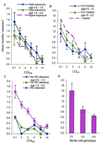Plasmodium falciparum genotypes, low complexity of infection, and resistance to subsequent malaria in participants in the Asembo Bay Cohort Project
- PMID: 11705960
- PMCID: PMC98874
- DOI: 10.1128/IAI.69.12.7783-7792.2001
Plasmodium falciparum genotypes, low complexity of infection, and resistance to subsequent malaria in participants in the Asembo Bay Cohort Project
Abstract
To assess the relationship between the within-host diversity of malaria infections and the susceptibility of the host to subsequent infection, we genotyped 60 children's successive infections from birth through 3 years of life. MSP-1 Block2 genotypes were used to estimate the complexity of infection (COI). Malaria transmission and age were positively associated with the number of K1 and Mad20 alleles detected (COI(KM)) (P < 0.003). Controlling for previous parasitemia, transmission, drug treatment, parasite density, sickle cell, and age, COI(KM) was negatively correlated with resistance to parasitemia of > 500/microl (P < 0.0001). Parasitemias with the RO-genotype were more resistant than those without this genotype (P < 0.0000). The resistance in low COI(KM) infections was not genotype specific. We discuss the impact of genotype-transcending immunity to conserved antigenic determinants. We also propose a diversity-driven immunomodulation hypothesis that may explain the delayed development of natural immunity in the first few years of life and suggest that interventions that decrease the COI(KM) could facilitate the development of protective immunity.
Figures





References
-
- al-Yaman F, Genton B, Reeder J C, Anders R F, Smith T, Alpers M P. Reduced risk of clinical malaria in children infected with multiple clones of Plasmodium falciparum in a highly endemic area: a prospective community study. Trans R Soc Trop Med Hyg. 1997;91:602–605. - PubMed
-
- Anders R F. Multiple cross-reactivities amongst antigens of Plasmodium falciparum impair the development of protective immunity against malaria. Parasite Immunol. 1986;8:529–539. - PubMed
-
- Arnot D. Unstable malaria in Sudan: the influence of the dry season. Clone multiplicity of Plasmodium falciparum infections in individuals exposed to variable levels of diseases transmission. Trans R Soc Trop Med Hyg. 1998;92:580–585. - PubMed
-
- Babiker H A, Abdel-Muhsin A A, Hamad A, Mackinnon M J, Hill W G, Walliker D. Population dynamics of Plasmodium falciparum in an unstable malaria area of eastern Sudan. Parasitology. 2000;120:105–111. - PubMed
-
- Baird J K. Age-dependent characteristics of protection v. susceptibility to Plasmodium falciparum. Ann Trop Med Parasitol. 1998;92:367–390. - PubMed
Publication types
MeSH terms
Substances
LinkOut - more resources
Full Text Sources
Research Materials

